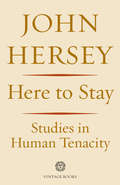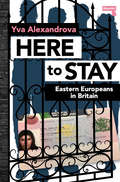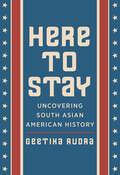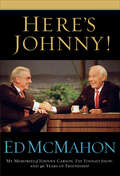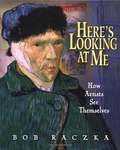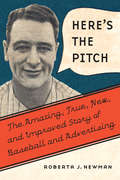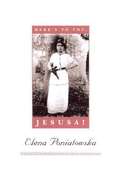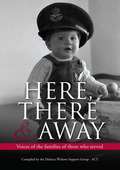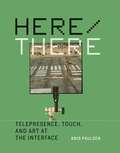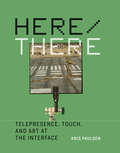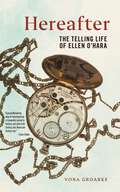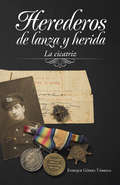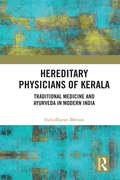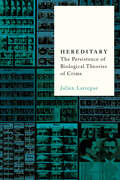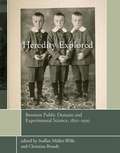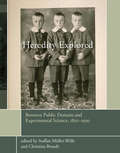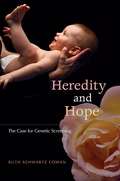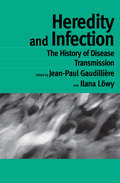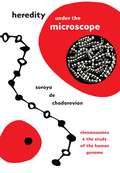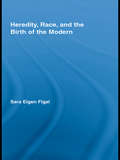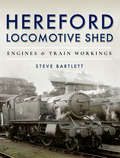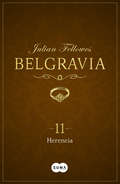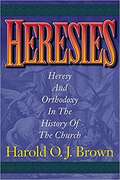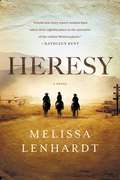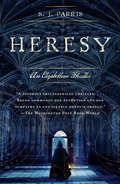- Table View
- List View
Here to Stay (Tesoro Bks.)
by John HerseyIn Here to StayJohn Hersey tells of episodes in the past twenty years in which Man has courageously risen above desperate situations and shown his determination to survive despite the threats of the nuclear age. Mr. Hersey first tells the story of an old lady marooned on a rooftop amidst floods caused by a hurricane. He ends with his famous Hiroshima, the story of the survivors of the first atomic bombing, written from personal investigation, with horrifying detail and compassionate indignation. Between these two pieces we read of John Kennedy’s heroism in rescuing the crew of his PT boat, sunk by the Japanese, seventeen years before he became President; a Jew’s suffering in Auschwitz; a crippled G.I.’s difficulties in adjusting himself to civilian life; the rehabilitation of a soldier paralyzed with fright; the adventures of two Poles who survived persecution; and a most moving account of an escape from Hungary in 1956. All John Hersey’s books have had a serious purpose. A Bell for Adanodrew attention to Italy’s plight; The Wall studied the Polish Jews’ struggle against tyranny; The War Lover exposed the war mentality;The Child Buyershowed up the exploitation of talent. Here to Stayis a stirring reminder of our inherent ability to meet the challenge of extinction which now faces the world.
Here to Stay: Eastern Europeans in Britain
by Yva AlexandrovaBulgarian writer and immigration expert Yva Alexandrova tells the story of Eastern European migrants in the UK, and argues for a more just, humane and compassionate immigration system.The arrival of Eastern European migrants to the UK after the enlargement of the EU in 2004 and 2011 was one of the key social transformations of the last twenty years in this country. Yet whilst reporting on this has focused mainly on the impact of immigration on the UK, and has been constructed of racist vox-pops and sensationalist political debate, there has been very little research on, and even less insight into, the experiences of the migrants themselves. Drawing on personal experience, interviews and research, Yva Alexandrova tells hers and the stories of other Eastern Europeans that came to the UK, and shows how attitudes to immigration have changed in the last twenty years in the wake of Brexit and a new wave of nativism that has swept across Britain. She argues that both the right and the left have made political compromises on migration, and makes a passionate and vivid argument for fair and just migration that is grounded in people&’s lived experiences and aspirations, and not in political expediency, as integral to progressive movements today. At a time when racism, xenophobia and nationalism dominate political discussion in the UK and around the world, Left Out: Eastern Europeans in Britain tells the stories of people who are rarely seen in debates on immigration.
Here to Stay: Uncovering South Asian American History
by Geetika RudraToday, South Asians are a rapidly growing demographic in the United States, comprising nearly 2 percent of the population. But there was a time in the not-too-distant past when the United States was far less hospitable to South Asian immigrants. In fact, until 1952, only white immigrants could become naturalized American citizens. Yet in the first half of the twentieth century, many states still had thriving communities of South Asians. In Here to Stay, Geetika Rudra, a second-generation Indian immigrant and American history buff, takes readers on a journey across the country to unearth the little-known histories of earlier generations of South Asian Americans. She visits storied sites such as Oregon’s “Hindoo Alley,” home to many lumber workers at the turn of the century, and Angel Island, California’s immigration hub. She also introduces readers to such inspiring figures as Bhagat Singh Thind, an immigrant who had enlisted in the U.S. Army to serve his adopted country in World War I, but who was later denied citizenship and took his case all the way to the U.S. Supreme Court. In turns both serious and joyful, this book vividly reveals how South Asians have always been a vital part of the American tapestry.
Here's Johnny!: My Memories of Johnny Carson, The Tonight Show, and 46 Years of Friendship
by Ed McMahonHere's Johnny is like sitting with Ed and Johnny over lunch:The last time I saw Johnny, about a year before he died, we had chicken, a couple of glasses of red wine, and then we just sat there and reminisced, going back and forth the way we did on the show. We talked about our kids, and our careers and the state of America, just two lucky guys who loved each other and the good luck of our careers.Ed McMahon is the only person who was with Johnny Carson, even before The Tonight Show, when they both first appeared on Who Do You Trust. Now, with Johnny's blessing before he died, McMahon can finally share all the stories that only he knows. From the sofa at Johnny's right, to backstage, to their personal relationship - McMahon will provide a real view of the man who was so careful to only show one side of himself to the public. Brilliant in front of the camera, but shy in person, Carson seldom gave interviews. Only McMahon can tell the stories and provide the insights into the personality that made Johnny Carson more of a friend we invited into our home than a television star.This entertaining tribute will feature over 200 pictures, many never before published, from both McMahon's and Carson's private archives.
Here's Looking at Me: How Artists See Themselves
by Bob RaczkaThis book introduces self portraits of painters and photographers painted in a variety of styles.
Here's the Pitch: The Amazing, True, New, and Improved Story of Baseball and Advertising
by Roberta J. NewmanIn the mid-nineteenth century, two industries arrived on the American scene. One was strictly a business, yet it helped create, define, and disseminate American culture. The other was ostensibly just a game, yet it soon became emblematic of what it meant to be American, aiding in the creation of a national identity. Today, whenever the AT&T call to the bullpen is heard, fans enter Minute Maid Park, or vote for favorite All-Stars (brought to us by MasterCard), we are reminded that advertising has become inseparable from the MLB experience.Here’s the Pitch examines this connection between baseball and advertising, as both constructors and reflectors of culture. Roberta J. Newman considers the simultaneous development of both industries from the birth of the partnership, paying particular attention to the ways in which advertising spread the gospel of baseball at the same time professional baseball helped develop a body of consumers ready for the messages of advertising. Newman considers the role of product endorsements in the creation of the culture of celebrity, and of celebrity baseball players in particular, as well as the ways in which new technologies have impacted the intersection of the two industries. From Ty Cobb to Babe Ruth in the 1920s and 1930s to Mickey Mantle, Yogi Berra, and Willie Mays in the postwar years, to Derek Jeter, Rafael Palmeiro, and David Ortiz in the twenty-first century, Newman looks at many of baseball’s celebrated players and shows what qualities made them the perfect pitchmen for new products at key moments.Here’s the Pitch tells the story of the development of American and an increasingly international culture through the marriage between Mad Men and The Boys of Summer that made for great copy, notable TV advertisements, and lively social media, and shows how baseball’s relationship with advertising is stronger than ever.
Here's to you, Jesusa!
by Elena Poniatowska Deanna HeikkinenJesusa is a tough, fiery character based on a real working-class Mexican woman whose life spanned some of the seminal events of early twentieth-century Mexican history. Having joined a cavalry unit during the Mexican Revolution, she finds herself at the Revolution's end in Mexico City, far from her native Oaxaca, abandoned by her husband and working menial jobs. So begins Jesusa's long history of encounters with the police and struggles against authority. Mystical yet practical, undaunted by hardship, Jesusa faces the obstacles in her path with gritty determination. Here in its first English translation, Elena Poniatowska's rich, sensitive, and compelling blend of documentary and fiction provides a unique perspective on history and the place of women in twentieth-century Mexico.
Here, There and Away: Voices of the Families of Those Who Served
by Defence Widows Support GroupHere, There & Away is a unique collection of entertaining stories from the families who support our service men and women. Spanning the three branches of the Australian Defence Force this is a literary first. The stories cover the period from World War I to more recent times, and celebrate the love, care and support given by and to members of the wider defence family as well as the resilience required in diverse locations and situations. Some stories will tug at the heart strings while others are funny in the extreme. Many touch on significant historical events. There are a number of stories that will surprise and enlighten – all within a gentler context than the normal genre of military history. The reader will be left pondering and maybe even enticed to further explore some aspects of Australian military history. The stories in Here, There & Away poignantly depict the ups and downs of everyday life for military families in times of war and peace, but they also reflect many aspects of life experienced by the wider community. This collection is an important contribution to Australian social and military history, and an entertaining and uplifting book for readers of all ages.
Here/There: Telepresence, Touch, and Art at the Interface
by Kris Paulsen"Telepresence" allows us to feel present -- through vision, hearing, and even touch -- at a remote location by means of real-time communication technology. Networked devices such as video cameras and telerobots extend our corporeal agency into distant spaces. In Here/There, Kris Paulsen examines telepresence technologies through the lens of contemporary artistic experiments, from early video art through current "drone vision" works. Paulsen traces an arc of increasing interactivity, as video screens became spaces for communication and physical, tactile intervention. She explores the work of artists who took up these technological tools and questioned the aesthetic, social, and ethical stakes of media that allow us to manipulate and affect far-off environments and other people -- to touch, metaphorically and literally, those who cannot touch us back.Paulsen examines 1970s video artworks by Vito Acconci and Joan Jonas, live satellite performance projects by Kit Galloway and Sherrie Rabinowitz, and CCTV installations by Chris Burden. These early works, she argues, can help us make sense of the expansion of our senses by technologies that privilege real time over real space and model strategies for engagement and interaction with mediated others. They establish a political, aesthetic, and technological history for later works using cable TV infrastructures and the World Wide Web, including telerobotic works by Ken Goldberg and Wafaa Bilal and artworks about military drones by Trevor Paglen, Omar Fast, Hito Steyerl, and others. These works become a meeting place for here and there.
Here/There: Telepresence, Touch, and Art at the Interface (Leonardo)
by Kris PaulsenAn examination of telepresence technologies through the lens of contemporary artistic experiments, from early video art through current “drone vision” works."Telepresence” allows us to feel present—through vision, hearing, and even touch—at a remote location by means of real-time communication technology. Networked devices such as video cameras and telerobots extend our corporeal agency into distant spaces. In Here/There, Kris Paulsen examines telepresence technologies through the lens of contemporary artistic experiments, from early video art through current “drone vision” works. Paulsen traces an arc of increasing interactivity, as video screens became spaces for communication and physical, tactile intervention. She explores the work of artists who took up these technological tools and questioned the aesthetic, social, and ethical stakes of media that allow us to manipulate and affect far-off environments and other people—to touch, metaphorically and literally, those who cannot touch us back.Paulsen examines 1970s video artworks by Vito Acconci and Joan Jonas, live satellite performance projects by Kit Galloway and Sherrie Rabinowitz, and CCTV installations by Chris Burden. These early works, she argues, can help us make sense of the expansion of our senses by technologies that privilege real time over real space and model strategies for engagement and interaction with mediated others. They establish a political, aesthetic, and technological history for later works using cable TV infrastructures and the World Wide Web, including telerobotic works by Ken Goldberg and Wafaa Bilal and artworks about military drones by Trevor Paglen, Omar Fast, Hito Steyerl, and others. These works become a meeting place for here and there.
Hereafter: The Telling Life of Ellen O'Hara (The Glucksman Irish Diaspora Series #6)
by Vona GroarkeWinner of the 2024 Michel Déon Prize for Non-FictionA lyrical portrait of a young Irish woman reinventing herself at the turn of the twentieth century in AmericaEllen O’Hara was a young immigrant from Ireland at the end of the nineteenth century who, with courage and resilience, made a life for herself in New York while financially supporting those at home. Hereafter is her story, told by Vona Groarke, her descendant, in a beautiful blend of poetry, prose, and history. In July 1882, Ellen O’Hara stepped off a ship from the West of Ireland to begin a new life in New York. What she encountered was a world of casual racial prejudice that characterized her as ignorant, dirty, and feckless, the butt of many jokes. From the slim range of jobs available to her she, like, many of her kind, found a position as a domestic servant, working long hours and living in to save on rent and keep. After an unfortunate marriage, Ellen determined to win financial security on her own, and eventually opened a boarding house where her two children were able to rejoin her. Vona Groarke builds this story from historical fact, drawing from various archives for evidence of Ellen. However, she also considers why lives such as Ellen’s seem to leave such a light trace in such records and fills in the gaps with memory and empathetic projection. Ellen—scrappy, skeptical, and straight-talking—is the heroine of Hereafter, whose resilience animates the story and whose voice shines through with vivid clarity. Hereafter is both a compelling account of an incredible figure and a reflection on how one woman’s story can speak for more than one life.
Herederos de lanza y herida: La cicatriz
by Enrique Gómez TárregaEs más sencillo conferenciar lo que no has vivido, que enjuiciar los comentarios. <P><P>Tan dañina como una mentira premeditada, puede ser una verdad a medias. Julio Robles, felizmente casado y padre de dos muchachas adolescentes a las que adoraba. <P>Él, que era un hombre tranquilo con una inteligencia bastante notable, escuchaba en silencio durante la habitual tertulia de la sobremesa de los días festivos, como uno de aquellos dos jóvenes a los que su hija mayor Mári había invitado a comer en su casa aquel día de domingo, en muestra de confraternidad y compañerismo, tras haber asistido juntos a una conferencia ofrecida por un, en aquellos momentos reputado personaje, en la que trataba de poner de manifiesto el trato discriminatorio a que estaban sometidos, los restos de los fallecidos durante la guerra civil, aquel se explayaba con eruditas divagaciones sobre un tema del que con sus palabras ponía de manifiesto no tener ni pajolera idea. <P><P>Mientras que él, para bien o para mal, bastantes años antes y de una manera un tanto imprevisible y sin habérselo propuesto, había alcanzado una licenciatura con revalida incluida sobre aquel mismo y escabroso tema, por eso en la primera ocasión que tuvo, tomó la palabra para poner algunos puntos ausentes sobre las íes, dejándoles muy claro e intentando sobre todo hacerles comprender a los allí presentes, que no era su intención condicionar ideológica-mente a nadie, explicándoles a continuación, que todas las cosas se ven según el color del cristal con que se miran.
Hereditary Physicians of Kerala: Traditional Medicine and Ayurveda in Modern India
by Indudharan MenonThis book examines the history and evolution of Ayurveda and other indigenous medical traditions in juxtaposition with their encounter with colonial modernity. Through the lens of hereditary folk and Ayurvedic practitioners, it focuses on Kerala’s heterogeneous medical traditions and presents them against the backdrop of the geographical, historical, sociocultural, ethnographic and regional contexts in which they developed and transformed. The author explores the world of Kerala’s last traditionally trained hereditary practitioners (folk healers, poison therapists, Sanskrit-speaking Muslim Ayurvedic practitioners and the legendary Brahman Ashtavaidyan physicians). He discusses the views of these physicians regarding the marked difference between their personalised ancestral methods of treatment and the standardised version of Ayurveda compliant with biomedicine that is practised by doctors today. Drawing on extensive fieldwork, this book will be useful to researchers and scholars of medical anthropology, health and social medicine, sociology and social anthropology, the history of science and modern Indian history, as well as to medical practitioners interested in alternative and traditional medicine.
Hereditary: The Persistence of Biological Theories of Crime
by Julien LarregueSince the 1990s, a growing number of criminal courts around the world have been using expert assessments based on behavioral genetics and neuroscience to evaluate the responsibility and dangerousness of offenders. Despite this rapid circulation, however, we still know very little about the scientific knowledge underlying these expert evaluations. Hereditary traces the historical development of biosocial criminology in the United States from the 1960s to the present, showing how the fate of this movement is intimately linked to that of the field of criminology as a whole. In claiming to identify the biological and environmental causes of so-called "antisocial" behaviors, biosocial criminologists are redefining the boundary between the normal and the pathological. Julien Larregue examines what is at stake in the development of biosocial criminology. Beyond the origins of delinquency, Larregue addresses the reconfiguration of expertise in contemporary societies, and in particular the territorial struggles between the medical and legal professions. For if the causes of crime are both biological and social, its treatment may call for medical as well as legal solutions.
Heredity Explored: Between Public Domain and Experimental Science, 1850--1930
by Staffan Müller-Wille Christina BrandtThis book examines the wide range of scientific and social arenas in which the concept of inheritance gained relevance in the late nineteenth and early twentieth centuries. Although genetics emerged as a scientific discipline during this period, the idea of inheritance also played a role in a variety of medical, agricultural, industrial, and political contexts. The book, which follows an earlier collection, Heredity Produced (covering the period 1500 to 1870), addresses heredity in national debates over identity, kinship, and reproduction; biopolitical conceptions of heredity, degeneration, and gender; agro-industrial contexts for newly emerging genetic rationality; heredity and medical research; and the genealogical constructs and experimental systems of genetics that turned heredity into a representable and manipulable object. Taken together, the essays in Heredity Explored show that a history of heredity includes much more than the history of genetics, and that knowledge of heredity was always more than the knowledge formulated as Mendelism. It was the broader public discourse of heredity in all its contexts that made modern genetics possible.ContributorsCaroline Arni, Christophe Bonneuil, Christina Brandt, Luis Campos, Jean-Paul Gaudillière, Bernd Gausemeier, Jean Gayon, Veronika Lipphardt, Ilana Löwy, J. Andrew Mendelsohn, Staffan Müller-Wille, Diane B. Paul, Theodore M. Porter, Alain Pottage, Hans-Jörg Rheinberger, Marsha L. Richmond, Helga Satzinger, Judy Johns Schloegel, Alexander von Schwerin, Hamish G. Spencer, Ulrike Vedder
Heredity Explored: Between Public Domain and Experimental Science, 1850-1930 (Transformations: Studies in the History of Science and Technology)
by Staffan Müller-Wille Christina BrandtInvestigations of how the understanding of heredity developed in scientific, medical, agro-industrial, and political contexts of the late nineteenth and early twentieth centuries.This book examines the wide range of scientific and social arenas in which the concept of inheritance gained relevance in the late nineteenth and early twentieth centuries. Although genetics emerged as a scientific discipline during this period, the idea of inheritance also played a role in a variety of medical, agricultural, industrial, and political contexts. The book, which follows an earlier collection, Heredity Produced (covering the period 1500 to 1870), addresses heredity in national debates over identity, kinship, and reproduction; biopolitical conceptions of heredity, degeneration, and gender; agro-industrial contexts for newly emerging genetic rationality; heredity and medical research; and the genealogical constructs and experimental systems of genetics that turned heredity into a representable and manipulable object. Taken together, the essays in Heredity Explored show that a history of heredity includes much more than the history of genetics, and that knowledge of heredity was always more than the knowledge formulated as Mendelism. It was the broader public discourse of heredity in all its contexts that made modern genetics possible.ContributorsCaroline Arni, Christophe Bonneuil, Christina Brandt, Luis Campos, Jean-Paul Gaudillière, Bernd Gausemeier, Jean Gayon, Veronika Lipphardt, Ilana Löwy, J. Andrew Mendelsohn, Staffan Müller-Wille, Diane B. Paul, Theodore M. Porter, Alain Pottage, Hans-Jörg Rheinberger, Marsha L. Richmond, Helga Satzinger, Judy Johns Schloegel, Alexander von Schwerin, Hamish G. Spencer, Ulrike Vedder
Heredity and Hope: The Case for Genetic Screening
by Ruth Schwartz CowanThe secrets locked in our genes are being revealed, and we find ourselves both enthused and frightened about what that portends. We look forward to curing disease and alleviating suffering--for our children as well as for ourselves--but we also worry about delving too deeply into the double helix. Abuses perpetrated by eugenicists--from involuntary sterilization to murder--continue to taint our feelings about genetic screening. Yet, as Ruth Schwartz Cowan reveals, modern genetic screening has been practiced since 1960, benefiting millions of women and children all over the world. She persuasively argues that new forms of screening--prenatal, newborn, and carrier testing--are both morally right and politically acceptable. Medical genetics, built on the desire of parents and physicians to reduce suffering and increase personal freedom, not on the desire to "improve the human race," is in fact an entirely different enterprise from eugenics. Cowan's narrative moves from an account of the interwoven histories of genetics and eugenics in the first half of the twentieth century, to the development of new forms of genetic screening after mid-century. It includes illuminating chapters on the often misunderstood testing programs for sickle cell anemia, and on the world's only mandated premarital screening programs, both of them on the island of Cyprus. Neither minimizing the difficulty of the choices that modern genetics has created for us nor fearing them, Cowan bravely and compassionately argues that we can improve the quality of our own lives and the lives of our children by using the modern science and technology of genetic screening responsibly.
Heredity and Infection: The History of Disease Transmission (Routledge Studies in the History of Science, Technology and Medicine)
by Jean-Paul Gaudillière Ilana LöwyIdeas about the transmission of disease have long formed the core of modern biology and medicine. Heredity and Infection examines their development over the last century. Two scientific revolutions - the bacteriological revolution of the 1890s and the genetic revolution at the start of the twentieth century - acted as the catalysts of major change in our understanding of the causes of illness. As well as being great scientific achievements, these were social and political watersheds that reconfigured the medical and administrative means of intervention. By establishing a clear distinction between transmission by infection and genetic transmission, this shift was instrumental in separating hygiene from eugenism. The authors argue that the popular perception of such a sharp divide stabilized only after 1945 when the use of antibiotics to end epidemics became commonplace. For health professionals the separation has never become an absolute one, and the book examines the various blends of heredity and infection that have preoccupied biology, medicine and the social sciences. Heredity and Infection recontructs the changing epidemiology of such historically important pathologies as tuberculosis , cancer and AIDS. In doing so, it demonstrates the role of experimental models, medical practices and cultural images in the making of contemporary biochemical knowledge.
Heredity under the Microscope: Chromosomes and the Study of the Human Genome
by Soraya de ChadarevianBy focusing on chromosomes, Heredity under the Microscope offers a new history of postwar human genetics. Today chromosomes are understood as macromolecular assemblies and are analyzed with a variety of molecular techniques. Yet for much of the twentieth century, researchers studied chromosomes by looking through a microscope. Unlike any other technique, chromosome analysis offered a direct glimpse of the complete human genome, opening up seemingly endless possibilities for observation and intervention. Critics, however, countered that visual evidence was not enough and pointed to the need to understand the molecular mechanisms. Telling this history in full for the first time, Soraya de Chadarevian argues that the often bewildering variety of observations made under the microscope were central to the study of human genetics. Making space for microscope-based practices alongside molecular approaches, de Chadarevian analyzes the close connections between genetics and an array of scientific, medical, ethical, legal, and policy concerns in the atomic age. By exploring the visual evidence provided by chromosome research in the context of postwar biology and medicine, Heredity under the Microscope sheds new light on the cultural history of the human genome.
Heredity, Race, and the Birth of the Modern
by Sara Eigen FigalThis book places under sustained scrutiny some of our most basic modern assumptions about inheritance, genealogy, blood relations, and racial categories. It has at its core a deceptively simple question, one too often taken for granted: what constitutes "good" bonds among humans, and what compels us to determine them so across generations as both a physical and a metaphysical attribute? Answering this question is complex and involves a foray into a seemingly disparate array of early modern sources: from adages, common law, and literature about bloodlines and bastardy to philosophical, political, and scientific discourses that both confirm and confound the "common sense" of familial, communal, national, and racial identity.
Hereford Locomotive Shed: Engines & Train Workings
by Steve BartlettHereford Locomotive Shed is the first in a series of in-depth studies to look closely at the changing engine allocations and operational responsibilities of motive power depots during the latter days of steam. In Herefords case this was a varied mixture of main line passenger, freight trip working, branch line passenger, station pilot duties and yard shunting. Unusually, the latter remained a steam preserve until months before depot closure in November 1964. Not forgotten are the depots small sub-sheds, which had varying responsibilities over the years, as the district boundaries changed at Ledbury, Leominster, Ross-on-Wye and Craven Arms. Their very different duties were inevitably a reflection of a bygone age and an all too rapidly changing future.The author personally recorded the Hereford railway scene from the late 1950s, until depot closure. He made shed visits several times a week, and at other times observed the ever-changing locomotive scene from the elevated Bulmers Sidewalk behind the depots coaling stage. Details carefully kept from those far-off days has proved a valuable cross reference with present-day research into Herefords role from official records at The National Archives, Kew, and other railway research sources.Having spent almost forty years working in the industry, the author is able to sympathetically unravel and interpret the story of this hard-working mixed traffic depot. Hereford is strategically located on the North & West route from South Wales and the West of England to the North West, as well as being an important junction for Worcester & the West Midlands. Branch lines to Brecon and Gloucester radiated from this Border Counties railway junction, and freight trips radiated out to serve the surrounding area. All of this made Hereford a fascinating rail centre and a locomotive shed worthy of its story for posterity, which is meticulously recorded in this book.
Herencia (Belgravia #11)
by Julian FellowesBelgravia, del creador de Downton Abbey, Julian Fellowes, es una historia publicada en 11 capítulos en la mejor tradición de las novelas por entregas. Y por fin el esperado desenlace. ¿Triunfará la justicia en este último capítulo? Muy cerca de Buckingham Palace, tras las puertas de las grandes mansiones del Londres victoriano reinan el escándalo y la intriga. Bienvenidos a Belgravia. Ambientada a mediados del siglo XIX, en una sociedad victoriana en la que los nuevos ricos de la industria y el comercio comienzan a codearse con la más arraigada aristocracia, Belgravia está poblada por un rico reparto de fascinantes personajes. Esta es la historia de un secreto. Un secreto que se oculta al otro lado de las elegantes puertas del barrio más exclusivo de Londres. Su historia será desvelada en capítulos sucesivos llenos de giros, revelaciones y finales inesperados. La crítica ha dicho...«Escrita con agilidad, esta novela te hace pasar las páginas a toda velocidad con el suspense de un thriller... Una lectura inteligente y envolvente que refleja de forma brillante un mundo que ya no existe.»Woman & Home
Heresies: Heresy and Orthodoxy in the History of the Church
by Harold O. BrownThe history of Christian theology is in large part a history of heresies, because Jesus and the claims he made . . . seemed incredible," writes the author.Heresies presents "the story of how succeeding generations of Christians through almost twenty centuries have tried to understand, trust, and obey Jesus Christ." Particularly concerned with christology and trinitarianism, the author calls on the four major creeds of the church-Apostles', Nicene, Athanasian, and Chalcedonian-to separate orthodoxy from heresy. He acknowledges that heresy has done much more than confuse and divide the church. It has also helped the church to classify orthodoxy. Just as heresy served this purpose historically, so it serves this purpose pedagogically in Heresies. <P><P> This volume presents a clarion call to evangelicals to preserve tenaciously "the faith once delivered to the saints." Frank E. James III wrote in theJournal of the Evangelical Theological Society: "Brown deserves to be commended not only for his insightful scholarship and his readable style but also and more importantly for providing a sorely-needed jab to the soft underbelly of modern evangelicalism."
Heresy
by Melissa LenhardtThey were the first and only all-female gang in the American West. Though the newspapers refuse to give them credit, their exploits don't go unnoticed. Now, they've got a rival male gang on their trail and an old score to settle.Margaret Parker and Hattie LaCour never intended to turn outlaw. After being run off their ranch by a greedy cattleman, their family is left destitute. As women alone they have few choices: marriage, lying on their backs for money, or holding a gun. For Margaret and Hattie the choice is simple. With their small makeshift family, the gang pulls off a series of heists across the West.Though the newspapers refuse to give the female gang credit, their exploits don't go unnoticed. Pinkertons are on their trail, a rival male gang is determined to destroy them, and secrets among the group threaten to tear them apart. Now, Margaret and Hattie must find a way to protect their family, finish one last job, and avoid the hangman's noose.For more from Melissa Lenhardt, check out:The Sawbones SeriesSawbonesBlood OathBadlands
Heresy (Giordano Bruno Novels #1)
by S. J. ParrisMasterfully blending true events with fiction, this blockbuster historical thriller delivers a page-turning murder mystery set on the sixteenth-century Oxford University campus.Giordano Bruno was a monk, poet, scientist, and magician on the run from the Roman Inquisition on charges of heresy for his belief that the Earth orbits the sun and that the universe is infinite. This alone could have got him burned at the stake, but he was also a student of occult philosophies and magic. In S. J. Parris's gripping novel, Bruno's pursuit of this rare knowledge brings him to London, where he is unexpectedly recruited by Queen Elizabeth I and is sent undercover to Oxford University on the pretext of a royal visitation. Officially Bruno is to take part in a debate on the Copernican theory of the universe; unofficially, he is to find out whatever he can about a Catholic plot to overthrow the queen. His mission is dramatically thrown off course by a series of grisly murders and a spirited and beautiful young woman. As Bruno begins to discover a pattern in these killings, he realizes that no one at Oxford is who he seems to be. Bruno must attempt to outwit a killer who appears obsessed with the boundary between truth and heresy. Like The Dante Club and The Alienist, this clever, sophisticated, exceptionally enjoyable novel is written with the unstoppable narrative propulsion and stylistic flair of the very best historical thrillers.From the Hardcover edition.
